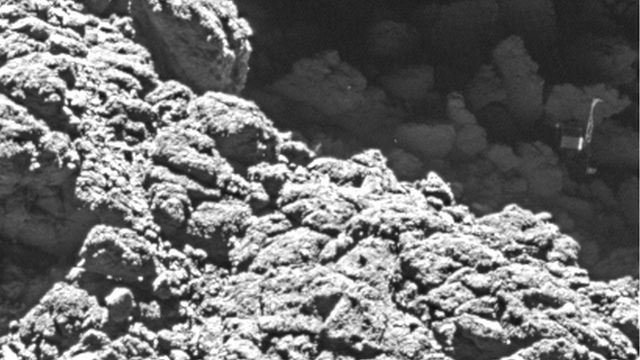Philae: Lost comet lander is found
- Published

Europe's comet lander Philae has been found.
The little robot is visible in new images downloaded from the Rosetta probe in orbit around the icy dirt-ball 67P/Churyumov-Gerasimenko.
European Space Agency (Esa) officials say there is no doubt about the identification - "it's as clear as day", one told the BBC.
Philae was dropped on to the comet by Rosetta in 2014 but fell silent 60 hours later when its battery ran flat.
Although it relayed pictures and data about its location to Earth, the lander's actual resting place was a mystery.
It was assumed Philae had bounced into a dark ditch on touchdown - an analysis now borne out by the latest pictures, which were acquired from a distance of 2.7km from the duck-shaped icy body.
The images from Rosetta's high-resolution Osiris camera were downlinked to Earth late on Sunday night, and have only just been processed.
Philae is seen wedged against a large over-hang. Its 1m-wide box shape and legs are unmistakable, however.
Rosetta had previously surveyed this location - dubbed Abydos - without success.
"Candidate detections" were made but none were very convincing.
The difference today is a closer-in perspective and a change in the seasons on the comet, which means the hiding place is now better illuminated.
The discovery comes just a few weeks before controllers plan to crash-land Rosetta itself on to the comet to formally end its investigation of 67P.
Although there is no hope of reviving the lander - some of its equipment will have been broken in the cold of space - simply knowing its precise resting place will help scientists make better sense of the data it returned during its three days of operation back in 2014.
"It was very important to find Philae before the mission ended, to understand the context of its in-situ scientific measurements," said Prof Mark McCaughrean, Esa's senior science advisor.
"But it was probably just as important to provide some emotional closure for the millions who have been following both Philae and Rosetta through the trials and tribulations of their exploration of this remarkable remnant of the birth of our Solar System.
"And there's one big final adventure to come on 30 September as Rosetta itself descends to the comet, doing unique science close-up before the mission ends for good," he told BBC News.
Comet 67P - "Space duck" in numbers

- A full rotation of the body takes just over 12.4 hours
- The axis of rotation runs through the "neck" region
- Its larger lobe ("body") is about 4.1 × 3.3 × 1.8 km
- The smaller lobe ("head") is about 2.6 × 2.3 × 1.8 km
- Gravity measurements give a mass of 10 billion tonnes
- Mapping estimates the volume to be about 21.4 cubic km
Jonathan.Amos-INTERNET@bbc.co.uk and follow me on Twitter: @BBCAmos
- Published30 June 2016
- Published12 November 2014
- Published15 November 2014
- Published13 November 2014